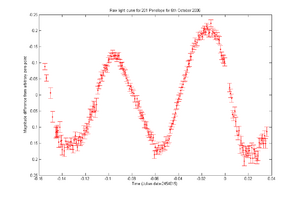Light curve facts for kids
In astronomy, a light curve is a graph that shows how bright an object in space is over time. This brightness is usually measured in a specific type of light, like visible light. Light curves can show patterns that repeat regularly. For example, the light from two stars orbiting each other or cepheid variable stars often repeats. Other light curves are irregular and don't have a pattern. This happens with objects like a nova, a supernova, or a microlensing event. By studying a light curve, scientists can learn a lot about what is happening with the object.
Studying Planets and Moons
Scientists who study planets (planetology) use light curves to find out how fast a small planet, moon, or comet spins. Many objects in our Solar System are too small to see clearly, even with the strongest telescopes on Earth. So, astronomers measure how much light these objects give off over time. This creates their light curve.
The time between the brightest points on the graph tells us how long it takes for the object to spin once. The difference between the brightest and dimmest points on the light curve can tell us about the object's shape or if it has bright and dark spots on its surface. For example, an asteroid that isn't perfectly round will usually have bigger ups and downs in its light curve. A more round object will have a flatter light curve. If a light curve covers a very long period of time, it's called a secular light curve.
Light Curves in Plants
In botany, which is the study of plants, a light curve shows how a leaf or algae responds to different amounts of light. It helps us understand how much photosynthesis (the process plants use to make food) is happening.
The shape of the curve shows how certain things can limit photosynthesis. When there isn't much light, the plant's ability to make food is limited by how much chlorophyll it has and how well its "light-dependent reactions" work. These are the first steps in photosynthesis. When there is a lot of light, the process is limited by a special helper chemical called RuBisCO and the amount of carbon dioxide available. The point where these two limits meet is called the light saturation point. At this point, the plant is getting more light energy than it can use to make food. Because carbon dioxide also affects photosynthesis, light curves for plants are often tested with different amounts of carbon dioxide.
Images for kids
-
This light curve shows how the brightness (magnitude) of the star δ Cephei changes as it pulsates.
-
These light curves compare how different types of supernovas change in brightness over time.
See also
 In Spanish: Curva de luz para niños
In Spanish: Curva de luz para niños





